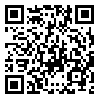Volume 20, Issue 3 (September 2022)
Iranian Rehabilitation Journal 2022, 20(3): 355-362 |
Back to browse issues page
Download citation:
BibTeX | RIS | EndNote | Medlars | ProCite | Reference Manager | RefWorks
Send citation to:



BibTeX | RIS | EndNote | Medlars | ProCite | Reference Manager | RefWorks
Send citation to:
Shafaghatian N, Bordbar A, Maroufizadeh S, Mirzakhani N, Amini M. The Predictive Effect of Individual and Environmental Factors on Motor Performance of Low Birth Weight Infants. Iranian Rehabilitation Journal 2022; 20 (3) :355-362
URL: http://irj.uswr.ac.ir/article-1-1387-en.html
URL: http://irj.uswr.ac.ir/article-1-1387-en.html
1- Department of Occupational Therapy, School of Rehabilitation Sciences, Iran University of Medical Sciences, Tehran, Iran.
2- Shahid Akbarabadi Clinical Research Development Unit, Iran University of Medical Sciences, Tehran, Iran.
3- Department of Biostatistics, School of Health, Guilan University of Medical Sciences, Rasht, Iran.
4- Department of Occupational Therapy, School of Rehabilitation Science, Shahid Beheshti University of Medical Sciences, Tehran, Iran.
5- Rehabilitation Research Center, School of Rehabilitation Science, Iran University of Medical Sciences, Tehran, Iran.
2- Shahid Akbarabadi Clinical Research Development Unit, Iran University of Medical Sciences, Tehran, Iran.
3- Department of Biostatistics, School of Health, Guilan University of Medical Sciences, Rasht, Iran.
4- Department of Occupational Therapy, School of Rehabilitation Science, Shahid Beheshti University of Medical Sciences, Tehran, Iran.
5- Rehabilitation Research Center, School of Rehabilitation Science, Iran University of Medical Sciences, Tehran, Iran.
Abstract: (3073 Views)
Objectives: Premature infants in the neonatal intensive care unit (NICU) are exposed to environmental risks that may cause developmental problems i. The present study aimed to investigate the predictive effect of individual and environmental factors on the motor performance of low birth weight preterm infants.
Methods: This cross-sectional study was performed in the neonatal clinic of Shahid Akbarabadi Hospital in Tehran City, Iran. A group of 90 low birth weight infants were enrolled in the study by non-probabilistic method and according to the inclusion criteria. Test of infant motor performance (TIMP), sensory profile2 (infant section), affordance in the home environment for motor development (AHEMD), and a demographic questionnaire were used to evaluate motor performance, sensory status, home environment, and other factors (birth weight, corrected age, parent’s education, etc.), respectively.
Results: TIMP elicited score was positively correlated with the infant’s age (r=0.390, P<0.001) and infant’s weight (r=0.260, P=0.011), and negatively correlated with duration of hospitalization in NICU (r=-0.210, P=0.047). A significant negative correlation was observed between TIMP elicited score and total infant sensory profile2 score (r=0.391, P<0.001) and a positive correlation was observed between TIMP elicited score and total affordance in the home environment for motor development score (r=0.207 P=0.049).
Discussion: The present study’s results showed that elicited movement has a significant relationship with infant sensory status and home environment and demographic variables (infant’s age, gender, infant’s weight, type of delivery, NICU duration, father and mother’s age, number of family children) and the sensory status has a more predictive effect on infant motor performance than the environmental questionnaire.
Article type: Original Research Articles |
Subject:
Occupational therapy
Received: 2021/06/11 | Accepted: 2021/09/4 | Published: 2022/09/19
Received: 2021/06/11 | Accepted: 2021/09/4 | Published: 2022/09/19
Send email to the article author








